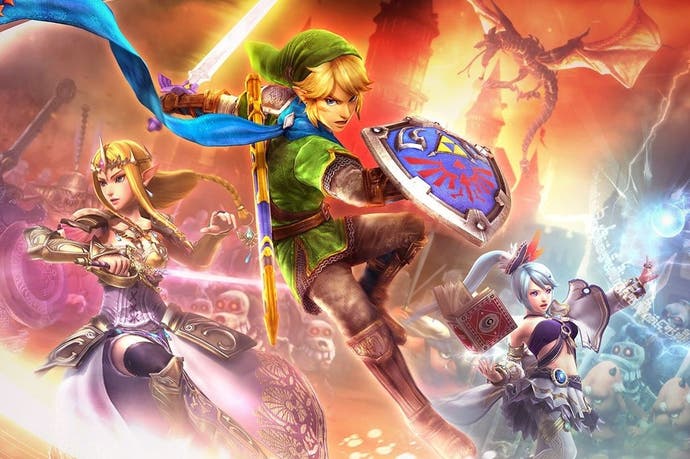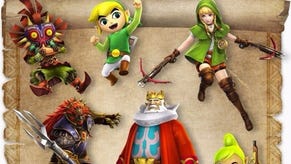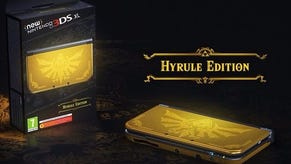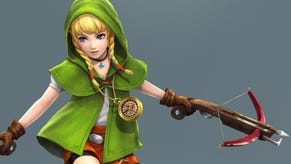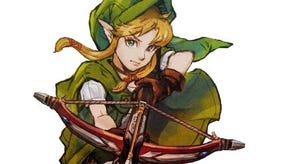How a passion for Zelda is driving Dynasty Warriors to fresh audiences
Via Miyamoto's "180 degree" table-flip, drinking and dreams of Star Wars.
Backed by a growing group of Western fans and a clever choice of franchise collaborations, a distinctly Japanese game series is slowly building itself a worldwide audience. Koei Tecmo's Dynasty Warriors (or "Musou") franchise now boasts nearly 40 incarnations, including team-ups with names as well known as Nintendo.
Originally a hack and slash series set on the front lines of feudal China, Dynasty Warriors has spread its wings and shared its formula of tactical battlefield domination to fit numerous other settings. But while collaborations with the Gundam or One Piece franchises may feed an already rabid Japanese fanbase, Dynasty Warriors is now making a play for serious global fame with last week's launch of the Legend of Zelda-themed Hyrule Warriors.
This latest Musou mash-up is a collaboration between Omega Force, Koei Tecmo's main Dynasty Warriors arm, and the top brains behind Nintendo's Zelda series, with Metroid: Other M studio Team Ninja helping on development duties. It's a love letter to the Zelda series but also a bright and colourful storefront for the Dynasty Warriors franchise itself, and overall a fine balance of the two series. "This is, if not the best Musou game yet, then certainly the most approachable and textured," Simon Parkin wrote in Eurogamer's recent Hyrule Warriors review. So how did this collaboration come about?
"Koei Tecmo and Nintendo have been close for a while, and we were talking about what we could do with the Wii U, what kind of new experience could we put out there," Team Ninja boss Yosuke Hayashi told Eurogamer during an interview at Tokyo Games Show. "Through those talks, the idea of combining the Warriors series and Zelda came together. Eiji Aonuma [Nintendo's Zelda series director] was a supervisor from there on in, and it was a very close working relationship. The reaction has been good - Zelda fans are really enjoying it."
But while the final product appears to have been well received, the project itself went through a drastic change during the early stages of development. Omega Force's first idea for the game would have made it something quite different - rather than a Zelda-flavoured Dynasty Warriors game, the team initially began building the opposite.
"Zelda is obviously a huge IP and for us as Japanese gamers, not just developers... well, everyone loves Zelda," Koei Tecmo exec and Omega Force leader Akihiro Suzuki said, explaining that having been given the keys to one of Nintendo's most iconic franchises, trying to make something as Zelda-like as possible was just too much to resist. "It's at the bottom of our hearts and is part of the roots of our gaming experience."
"The Zelda series is of course a really beloved, legendary series," Hayashi agreed. "It's always amongst people's favourite games. We, as fans, were also looking at that, and saying okay - let's make a Zelda game!"
And so the game's developers went to work, faithfully building something whose gameplay befitted an entry in Nintendo's legendary series. It wasn't an attempt to muscle in and claim any form of ownership for the franchise, but an unintended by-product of being so familiar with its mechanics and mannerisms - and being too cautious about what fans would expect from a new title set in the Zelda universe.
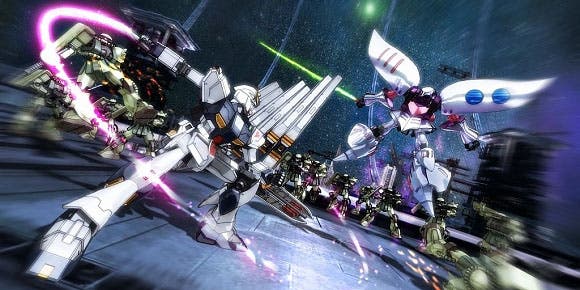
"To start with, when the idea kicked off, the image we had of Zelda was actually implemented in the game - the puzzle solving, RPG approach of a Zelda title," Suzuki continued. "They are the essential parts and we started to implement them." But when Nintendo - and specifically Shigeru Miyamoto - saw what Omega Force was building, it felt the need to intervene.
"At that point Miyamoto-san and Nintendo came to us and said 'this doesn't feel like cross-IP game, this is more just like a Zelda game' and that if it was just going to feel like a Zelda game there was no point in doing a cross-collaboration."
"We got the direction [from Nintendo] of making it something more in line with our skillset," Hayashi added, "and in terms of how we could bring to the franchise something we're strong with. It was very early in production, at a very early design phase, that those discussions happened. It was more of a collaboration about what we could do with that IP."
Nintendo was keen for the game to be coloured by a cast of Zelda faces and some of the series' most iconic locations - but that these features would remain elements of a firmly Dynasty Warriors-style experience, one whose gameplay would be familiar to fans if they had already played other Musou titles.
"Dynasty Warriors is like a genre, like FPS," Suzuki explained, and in his opinion, anyone who has played a title in the series "has such a strong feeling of what the games are about." It was to this blueprint that the team then returned. "The actual feel of the game was changed pretty much 180 degrees from what we were doing in our early stages of development as opposed to what we have now. If you had played the early stage build you'd say it was much more like an action RPG game rather than any kind of DW game.
"What you see now is the outcome of that decision," he concluded, "and when you play the game now it feels like Dynasty Warriors, rather than Zelda."
But Omega Force is keen to point out that, apart from the early change in direction, its partnership with Nintendo was otherwise a smooth collaboration. And that the very existence of the collaboration in the first place suggests there are Dynasty Warriors fans inside Nintendo, as well as Zelda fans inside Koei Tecmo.

"Mr. Miyamoto only did his signature table-flipping once," Hayashi reassured. "It was only once during the entire production - the rest of the time he was pretty positive about what we showed, and what we were able to present. Mr. Aonuma was trying to get us to break out of our ideas of what Zelda was - we were trying to make it like Zelda and he said no, break out and do something different. He was really encouraging us to explore more."
Hayashi declined to detail specifics of the table-flipping incident, although confirmed that no actual tables were involved. And, in any case, Omega Force is a veteran of dealing with external companies and their franchises, and of balancing the Dynasty Warriors' footprint even when delving head-first into already well-established worlds.
"It's not new for us to collaborate on titles with the Musou engine," explained Hisashi Koinuma, Hyrule Warrior producer and another of Omega Force's leading figures. "It's not something new for us, them recommending we should make it more Dynasty Warriors in a sense. It's actually more of a challenge to have the right balance, and bring the right fun in the game for the fans. It's been going on since day one."
But how about before day one of a project? How do Koinuma and Suzuki make the deals which lead to them to franchises such as Gundam and One Piece - series which, although relatively unheard of in the West, are huge names in Japan. It turns out that such expansive projects are dreamt up in a surprisingly casual manner.
"It's usually while we drink..." Koinuma laughed, half-joking. "Actually, the drinking part is true to an extent. There's no typical pattern for how these collaborations begin - it could be a game we dream up in a drinking session, it could be something through our contacts in the industry. There are a lot of variations."
One dream shared by both Koinuma and Suzuki would be to create a Dynasty Warriors game in a very specific universe, or galaxy.
"It's a personal opinion but I'd love to work with Star Wars one day, if I got the chance," Suzuki chuckled. Koinuma separately agreed. "Without any restrictions or anything, the ideal dream would be to work on Star Wars," he said. It feels like something that has definitely been discussed amongst team members - even if it was just down the pub.
"One of my ultimate dreams would be using that character with the red hat on top," Koinuma mused, considering other Nintendo characters. "There is a Smash Bros. coming out, we do see a lot of different characters coming together in an all-star roster, so hopefully in the long run we can work with Nintendo on something with a similar line, where we can provide or deliver something Nintendo can't in a sense with their own IP."
It also makes sense that future collaborations are more Western-leaning, to grow the series' appeal. "The Dynasty Warriors series has been a big hit in Japan from its first instalment and has been growing since," Suzuki agreed. "In Europe and the overseas market it's still a niche market but we're growing it bit by bit."
But, first things first. The team is now building four big DLC drops for Hyrule Warriors, each of which will add new maps, game modes, costumes and characters. This bustling schedule of expansion content will continue well into next year. And then there's also the small matter of Dragon Quest Heroes, the studio's next major team-up. While perhaps not as well known in the West as Zelda, the upcoming Dragon Quest collaboration with Square Enix is another example of the Musou series' increasing ability to snag high profile franchises - and in doing so extend knowledge of its own brand.
"We're really busy at the moment," Koinuma concluded. "We look at reinforcing the team at Omega Force year by year, and we see them growing bit by bit. Omega Force has been going now for 15 years. The younger generation that played the games when they were young, they're now working at the companies making the games. There's a nice loop there." Perhaps in the future that will also contain some of the growing Western fans of the series too.
